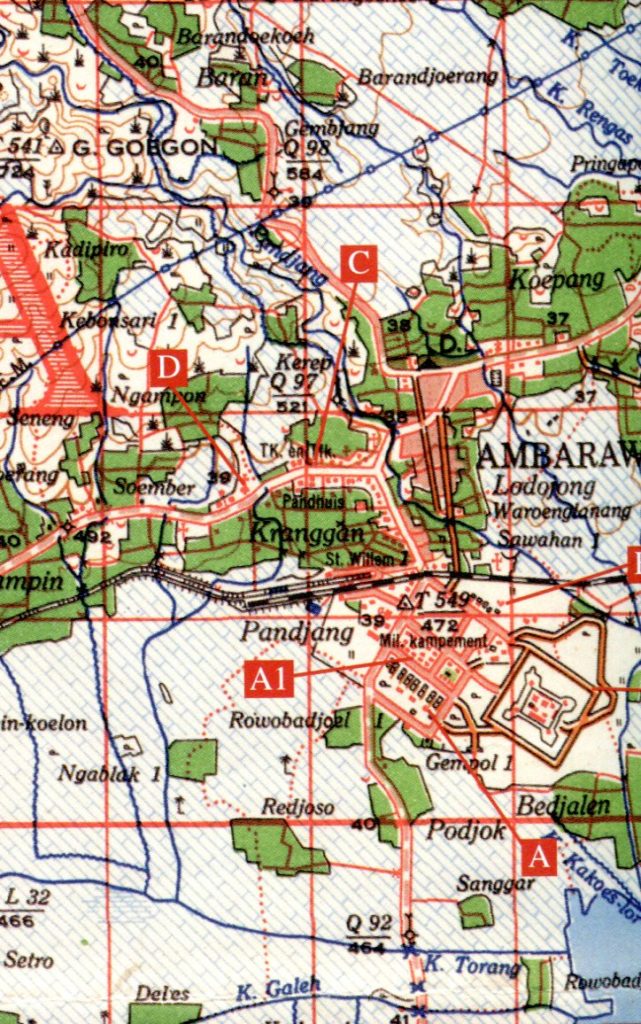Ambarawa
Ambarawa

Copied from Geillustreerde Atlas van de Japanse Kampen in Nederlands Indie (Asia Maior)
Ambarawa area in central Java held a large number of civilian prisoners at the end of the war in three separate camps, near the present day eponymous village on the shores of lake Rowo Penning.
These three camps indicated on the map as Ambarawa 6 (women and children) at A, Ambarawa 7 (boys and men ) at B. Ambarawa 9 (women and children ) at D. Boys and men originally housed in Ambarawa 8 (C ) were transferred to Ambarawa 7, shortly before the end of the war.
These prison camps were administered by the Japanese Imperial army as part of BUNSHO III, based in Semarang.
Before the war this had been the site of a Dutch Colonial army military camp, called Fort Willem (indicated on the map above A).
Ambarawa details
Ambarawa 6 camp for women and children held about 4000 women and children at the end of the war. A list of names survived. Note that there are three lists of names, in alphabetical groupings (A-F, G-L,M-R , S-Z)
Ambarawa 7 held 2500 men and boys but no list of names survived. This camp also held some nuns.
Three names lists have however survived from Ambarawa 8, and these people ended up in Ambarawa7. There is a list of boys with ages indicated. A list survived of old men , (including those who had died before the war ended and while still in Ambarawa 8) . There is also a list of men, including deaths) . This last lists is described as Bandoengers- moved her from Bandung. These three lists thus account for xxx out of the total population of 2500.
Published material
Because of the chaos that erupted in this part of Java after the capitulation of Japan, few records have survived. The book by Wiedermaier provides an account of the circumstances in the boy’s camp. The accompanying painting by Yvonne van der Kooi also reflects the situation faced by these young internees.
In the publication, Four Years till Tomorrow, an English translation of a poem written in Camp Ambarawa by Geertruida van Leenhoff Weygers on 15 August 1944 is included as an entry, and its first stanza is reproduced below:
“Tired of life, as it is now,/ Tired of waiting for peace, still, with a silent smile I see my children enter my space.”
By “space” the poetess refers to the tiny area in a barrack like environment, that she could call “home”. These areas were carefully measured in centimeters and jealously demarcated. There was absolutely no privacy
Postwar Camp Visits
Shortly after the Japanese capitulation Dr. J.U Kapeler, a Swiss national, visited Ambarawa 7 to look for his father-in-law, who had died. He nevertheless made a number of photographs of Banjubiru 10.
September 19 &2 0 Nicola Drakulic and Valentin Schreiber visited the Ambarawa area and took photographs (Fort Willem, Ambarawa 7 and Banju Biru 10). These photographs were reproduced in de Kamp Atlas ( Asia Maior, 2002)
On 24 September Lady Edwina Mountbatten visited the camp with the help of her commandeered bomber. Various members of her party made photographs.
Some of the photographs are available via the NIOD in Amsterdam and many are also reproduced in various editions of the Geillustreerde Atlas van de Japanse Kampen ( Asia Maior, publisher)
Evacuation of Ambarawa & Banjubiru
(https://www.iwm.org.uk/collections/item/object/1060034226
This series of 8mm B&W films show various scenes during the British evacuation operation that took place between 24 November and 14 Deember,1945. Fort Willem (Note shots of the main entrance to Roema Pendjara Ambarawa,) functioned as a makeshift evacuation centre.
Photos
A large number of annotated images can be found in the Drakolic Photo album
Leave a Reply